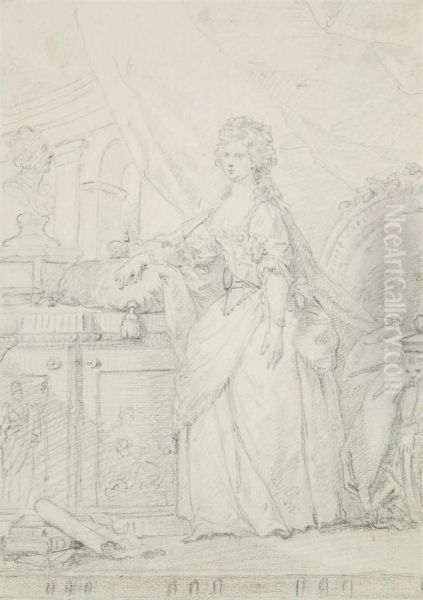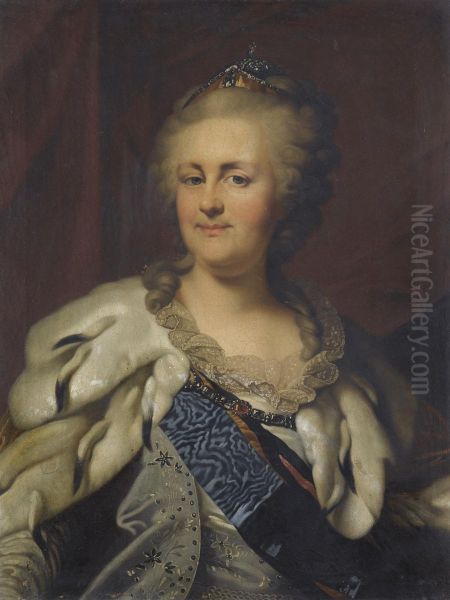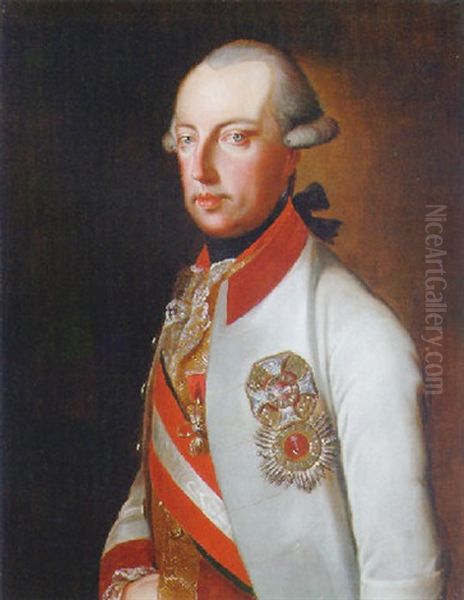Johann Baptist von Lampi the Elder stands as a significant figure in late 18th and early 19th-century European art. An artist of Austro-Italian heritage, his career traversed the great courts and cultural capitals of Europe, from Vienna to Warsaw and St. Petersburg. Renowned for his elegant and insightful portraits, Lampi captured the likenesses of emperors, kings, tsars, and a constellation of a_ristocratic society, leaving behind a rich visual record of an era on the cusp of profound change. His ability to adapt his style, combined with his technical skill, ensured his popularity and lasting legacy.
Early Life and Artistic Foundations
Johann Baptist Lampi, later ennobled as von Lampi, was born on December 31, 1751, in Romeno, a village in the Val di Non, Tyrol, which was then part of the Habsburg Austrian Empire (now in Trentino, Italy). His artistic inclinations were likely nurtured from a young age, as his father, Matthias Lampi (Matteo Lampi), was a respected decorative and fresco painter. This familial environment provided the young Johann Baptist with his initial exposure to the rudiments of art, learning directly from his father's practice.
Seeking more formal training, Lampi's formative years saw him travel to various artistic centers. He initially studied under his father, absorbing the traditions of local Tyrolean art. His ambitions soon led him to Salzburg, where he further honed his skills. Verona was another important stop in his artistic pilgrimage, where he would have been exposed to the rich artistic heritage of the Veneto region, with its legacy of masters like Titian and Veronese, whose influence on color and composition was pervasive.
His education continued in Trento, where he reportedly studied under Domenico Zeni and later, more significantly, with Francesco Lorenzi, a painter who had himself been a pupil of the celebrated Giovanni Battista Tiepolo. This connection to the Tiepolo lineage would have instilled in Lampi a sense of grand manner painting, characterized by luminous color and dynamic compositions, even if Lampi's primary focus would become portraiture. It was in Trento that he began to specialize in portraiture and smaller cabinet paintings, laying the groundwork for his future success.
Ascent in Vienna and Academic Recognition

By 1773, Johann Baptist Lampi had made his way to Vienna, the vibrant capital of the Habsburg Empire. This was a crucial move, placing him at the center of a sophisticated artistic milieu. In Vienna, he continued his studies, possibly with Hubert Maurer or Franz Edmund Weirotter at the prestigious Academy of Fine Arts. He quickly established himself as a talented portraitist, gaining favor among the Viennese nobility and bourgeoisie.
His skill did not go unnoticed by the imperial court. Lampi's ability to render not only a faithful likeness but also to imbue his sitters with an air of dignity and elegance resonated with the tastes of the time. He received commissions from Emperor Joseph II, a monarch known for his Enlightenment ideals and patronage of the arts. This imperial endorsement significantly boosted Lampi's reputation.
In 1786, a testament to his standing in the Viennese art world, Lampi was appointed a professor at the Vienna Academy of Fine Arts. This was a position of considerable prestige, acknowledging his mastery and his capacity to instruct others. During this period, he would have been aware of, and perhaps in friendly competition with, other prominent Viennese artists such as Heinrich Friedrich Füger, another leading portraitist and historical painter who also enjoyed imperial favor. Anton von Maron, a pupil and son-in-law of Anton Raphael Mengs, was another significant classicizing painter active in Rome but whose influence reached Vienna.
Lampi's Viennese portraits from this era often display a refined Rococo sensibility, characterized by delicate brushwork, soft lighting, and an emphasis on the luxurious textures of fabrics and adornments. However, a growing Neoclassical clarity and sobriety also began to inform his work, reflecting the broader stylistic shifts occurring across Europe.
The Polish Interlude: Court Painter in Warsaw
Lampi's fame had by now spread beyond the borders of the Austrian Empire. In 1787 or 1788, he received a prestigious invitation from King Stanisław August Poniatowski of Poland. The Polish king was a renowned connoisseur and patron of the arts, actively seeking to elevate Warsaw as a major European cultural center. Lampi accepted the invitation and traveled to Warsaw, where he was appointed court painter.

In Warsaw, Lampi found a receptive audience and a court eager for his talents. He painted numerous portraits of the King, members of the royal family, and prominent figures of the Polish aristocracy, such as the Potocki and Czartoryski families. His predecessor in royal favor, Marcello Bacciarelli, an Italian painter who had long dominated the Warsaw art scene, was still active, creating an environment of potential artistic rivalry, though Lampi's fresher style quickly gained ascendancy for new commissions. Other artists active in Poland at the time included Jean-Pierre Norblin de La Gourdaine, a French painter who documented Polish life and historical events.
Lampi's Polish period saw him produce some of his most accomplished works. His portraits of King Stanisław August are particularly noteworthy, capturing the monarch's intellectual and melancholic demeanor. These works often combined regal formality with a sense of personal intimacy. His style during this period continued to evolve, blending Rococo charm with an increasing Neoclassical structure and psychological depth. He remained in Poland for a few years, but the political instability of the country, which was heading towards its final partitions, likely influenced his decision to seek opportunities elsewhere.
The Russian Zenith: Imperial Favor in St. Petersburg
In 1791 or 1792, Lampi embarked on the next major phase of his career, moving to St. Petersburg at the invitation of the Russian imperial court, likely facilitated by recommendations from his Polish patrons. Empress Catherine the Great, an avid art collector and a monarch who consciously used art to project power and enlightenment, was keen to attract talented European artists to her capital.
Lampi's arrival in Russia marked the beginning of a highly successful period. He quickly became the most sought-after portraitist in St. Petersburg, eclipsing for a time even established Russian masters like Dmitry Levitzky and Vladimir Borovikovsky, who were themselves formidable talents in the realm of portraiture. Fedor Rokotov was another major Russian portraitist of the era, though his peak was slightly earlier. Lampi also found himself among other foreign artists, such as the French painter Jean-Louis Voille, and later, Élisabeth Vigée Le Brun, who arrived in St. Petersburg in 1795 and also enjoyed immense success.
Lampi painted several iconic portraits of Catherine the Great, depicting her with imperial majesty yet also hinting at her formidable intellect. These works became official representations of the Empress. He also portrayed her son and successor, Paul I, and later, Tsar Alexander I, along with numerous members of the imperial family and the highest echelons of Russian nobility. Figures like Prince Grigory Potemkin, Field Marshal Alexander Suvorov, and members of the Shuvalov, Yusupov, and Sheremetev families sat for him.

His Russian portraits are characterized by their grandeur, rich coloration, and meticulous attention to detail, particularly in the rendering of uniforms, decorations, and lavish attire. He adeptly conveyed the status and power of his sitters, often employing grand architectural backgrounds or symbolic accoutrements. While maintaining a high degree of finish and elegance, his best Russian works also reveal a keen psychological insight. Beyond formal portraits, Lampi also undertook decorative projects, including ceiling paintings for imperial residences, showcasing his versatility. He was made an honorary member of the St. Petersburg Academy of Arts in 1794 and later a full member and professor, further solidifying his esteemed position.
Artistic Style, Technique, and Representative Works
Johann Baptist von Lampi the Elder's artistic style evolved throughout his career, reflecting both his personal development and the broader shifts in European taste. His early work was rooted in the late Baroque and Rococo traditions prevalent in Central Europe and Italy. This is evident in the graceful poses, soft modeling, and attention to the sensual qualities of materials in his earlier portraits.
As he matured, and particularly during his time in Vienna and Warsaw, Neoclassical influences became more apparent. This manifested in clearer compositions, more defined forms, and a greater emphasis on conveying the character and virtue of the sitter, in line with Enlightenment ideals. However, Lampi never fully abandoned the elegance and painterly richness of his earlier training, creating a distinctive blend that appealed to his aristocratic clientele.
His technique was highly accomplished. He possessed a remarkable ability to capture a likeness, a fundamental requirement for a successful portraitist. His brushwork could be both refined and fluid, capable of rendering the smoothness of skin, the sheen of silk, the glitter of jewels, and the robust textures of military uniforms with equal facility. His color palettes were typically rich and harmonious, often employing deep reds, blues, and golds to enhance the sense of opulence and dignity.
Among his many representative works, several stand out:
Portraits of Emperor Joseph II: These established his reputation in Vienna and showcase his early mature style.
Portraits of King Stanisław August Poniatowski: These are considered among his finest achievements, capturing the Polish king's intellectual and somewhat melancholic character. The "Portrait of Stanisław August Poniatowski with an Hourglass" is a particularly poignant example.
Portraits of Empress Catherine the Great: Multiple versions exist, some full-length and highly formal, others more intimate. These became iconic images of the Russian Empress in her later years.
Portrait of Prince Grigory Potemkin: A powerful depiction of Catherine's influential favorite.
Portrait of Field Marshal Alexander Suvorov: Capturing the stern and determined character of the renowned Russian military commander.
Self-Portrait with his Sons (circa 1805): This work, depicting himself with Johann Baptist the Younger and Franz Xaver, offers a more personal glimpse of the artist and his familial artistic lineage.
Portrait of Countess Maria Theresia Bucquoi, née Paar (c. 1785-1790): An example of his Viennese period, showcasing elegance and refined Rococo charm.
Portrait of Empress Maria Feodorovna (wife of Paul I): Lampi painted several members of Paul I's family, contributing to the visual record of the Russian imperial dynasty.
His ability to adapt to the specific demands of different courts and patrons, while maintaining a consistently high level of quality, was a key to his international success. He understood the importance of portraiture as a statement of power, status, and cultural refinement.
Family and Artistic Dynasty
Johann Baptist von Lampi the Elder was not the only artist in his family. His father, Matthias, was a painter, and Lampi passed on his artistic talents and profession to his own sons, establishing a notable, if short-lived, artistic dynasty.
His eldest son, Johann Baptist von Lampi the Younger (1775–1837), followed closely in his father's footsteps. He trained with his father and also studied at the Vienna Academy. He accompanied his father to St. Petersburg and worked there for a period, assisting him and also establishing his own reputation as a portraitist. After his father's return to Vienna, Johann Baptist the Younger also eventually returned and became a successful portrait painter in his own right, working in a style very similar to his father's, sometimes making attribution difficult. He, too, became a professor at the Vienna Academy.
His second son, Franz Xaver von Lampi (1782–1852), also became a painter, specializing in portraits and, to some extent, historical subjects. Unlike his elder brother, Franz Xaver spent a significant part of his career in Warsaw, which had become part of the Russian Empire after the partitions of Poland. He became a respected artist there, continuing the Lampi family's connection with Polish patrons. The provided information suggests a possible estrangement from his father, a poignant detail that hints at the complexities of family dynamics even within artistic circles.
The continuation of the Lampi name in the art world through his sons underscores the elder Lampi's influence, not only on his contemporaries but also directly within his own family. Their work, while perhaps not reaching the same heights of international fame as their father's, contributed to the dissemination of his elegant portrait style.
Anecdotes, Competition, and Cultural Impact
Lampi's career was not without its interesting facets and interactions. His move to St. Petersburg placed him in a competitive environment. While he was highly favored, he worked alongside and sometimes vied for commissions with talented Russian artists like Dmitry Levitzky and Vladimir Borovikovsky. Levitzky, an established master, was known for his psychologically penetrating portraits, while Borovikovsky developed a more sentimental, proto-Romantic style. Lampi's international polish and grand manner offered a different, but equally appealing, vision to the Russian aristocracy.
The presence of other foreign artists, such as Élisabeth Vigée Le Brun, who arrived in Russia a few years after Lampi, also added to the vibrant artistic scene. Vigée Le Brun, famous for her portraits of Queen Marie Antoinette, brought a distinct French elegance. The Russian court became a nexus where various European artistic currents met and mingled.
The mention of Catherine the Great's personal life in the provided information, while perhaps tangential to Lampi's art directly, underscores the colorful and often larger-than-life personalities he encountered and painted. His role was to capture their official personas, but the underlying human stories were often rich and complex.
Lampi was also involved in the academic side of art. His professorships in Vienna and St. Petersburg indicate a commitment to teaching and the theoretical aspects of art. The provided text mentions his involvement in reforms at the St. Petersburg Academy and that he authored theoretical works, highlighting his intellectual engagement with his profession beyond the mere execution of paintings.
A more modern anecdote, the restitution of one of his works to a Jewish family, speaks to the enduring value and complex histories that can become attached to artworks over centuries, as they pass through various collections and historical upheavals.
Later Years, Return to Vienna, and Enduring Legacy
After a highly productive and successful period in Russia spanning over a decade, Johann Baptist von Lampi the Elder eventually decided to leave St. Petersburg. According to most established art historical accounts, he returned to Vienna in 1822, not 1812 as some earlier sources might suggest, and certainly not retiring and dying in St. Petersburg as the initial prompt's text stated. Upon his return to Vienna, he was a celebrated figure. He was granted the status of honorary citizen of Vienna, a significant recognition of his contributions.
He spent his final years in the Austrian capital, the city where his international career had truly begun. He passed away in Vienna on February 11, 1830, at the age of 79, leaving behind a substantial oeuvre and a significant reputation.
Johann Baptist von Lampi the Elder's legacy is multifaceted. He was one of the preeminent portrait painters of his generation, his career notable for its pan-European scope. His works provide an invaluable visual chronicle of the ruling and aristocratic classes of Austria, Poland, and Russia during a transformative period in European history. His portraits are prized not only for their artistic merit—their elegance, technical skill, and often insightful characterization—but also as historical documents.
He influenced a generation of portraitists in the countries where he worked, particularly in Russia, where his style contributed to the development of academic portraiture. His sons carried on his artistic tradition, further cementing the Lampi name in the annals of art history. Artists like Orest Kiprensky, a leading Russian Romantic portraitist, would have been aware of Lampi's work and the standards he set.
His paintings are held in major museums and private collections worldwide, including the Hermitage Museum in St. Petersburg, the National Museum in Warsaw, the Belvedere in Vienna, and many others. They continue to be studied for their artistic qualities and their depiction of a bygone era of courtly splendor.
Conclusion
Johann Baptist von Lampi the Elder was more than just a skilled craftsman; he was an astute observer of character and a master of conveying status and elegance. From the Tyrol of his birth to the imperial courts of Vienna, Warsaw, and St. Petersburg, he navigated the complex world of aristocratic patronage with remarkable success. His artistic journey reflects the interconnectedness of European culture in the late 18th and early 19th centuries, and his portraits remain compelling testaments to the individuals who shaped this era. His ability to blend late Baroque grace with Neoclassical clarity, all while infusing his works with a distinctive personal touch, secures his place as a distinguished master in the history of European portraiture. His contemporaries included some of the finest painters of the age, such as Thomas Lawrence in England, Jacques-Louis David and Jean-Auguste-Dominique Ingres in France, and Francisco Goya in Spain, each defining portraiture in their national contexts, while Lampi carved his niche across Central and Eastern Europe.